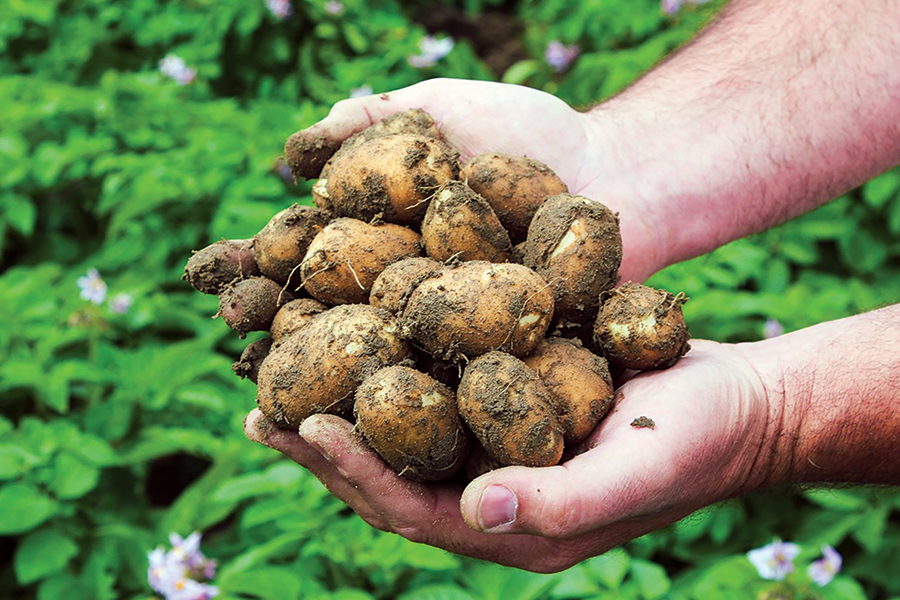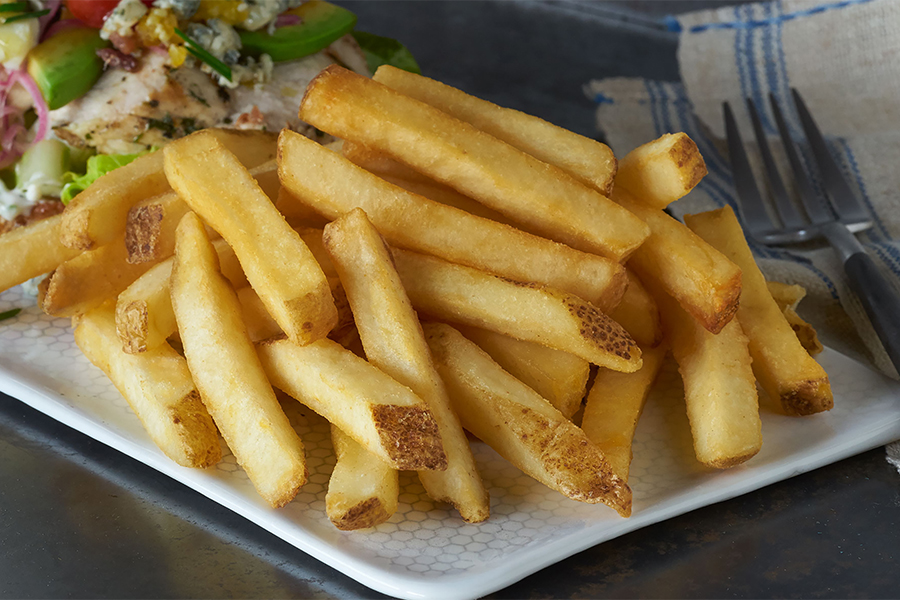
Home » A beast of a market grips potato industry
Surplus spuds
A beast of a market grips potato industry

A potato farm in north Pasco.
Photo by Jamie CouncilJune 14, 2024
It’s a tale as old as time — to borrow a line from “Beauty and the Beast” — this ag tale of supply and demand.
For potato farmers, the beast in this story is the uncertainty of the market combined with a surplus of spuds.
“It’s simple economics,” said Chris Voigt, executive director of the Washington State Potato Commission. “When there’s too much product out there and not enough demand, the price goes down and prices are almost at a historical low.”
During the pandemic, the demand for potatoes was high, thanks to worldwide cravings for fast food potato products.
Post-pandemic yields were devastated by record-breaking temperatures. Farmers were able to cash in on the profit margins during that time, prompting others to get some skin in the game and leaving the industry wondering if the price increases would drive consumers away.
“I think the overall production was down 10%,” Voigt said, “and that caused the price to go up anywhere from 200% to 300%. We like our growers making money, but for long-term demand, it’s not good for the industry.”
An increase in potato acreage, shifts in processors’ business models and ideal growing conditions mean the surplus has led to no shortage of problems.
“The potato world has been crazy since Covid,” said Mike Pink, a potato farmer in Pasco. “It’s been all over the place. We went from being short where they would take all they could get, to being long, to now changing markets. The demand is great, which is fantastic, but there’s no calmness in my world.”
The good news is the 2024 crop is shaping up to be a good one, but the bad news is some farmers aren’t sure what to do with their extra potatoes.
“That’s a common theme throughout all agriculture,” Voigt said. “When prices are high, everyone wants to get on board, and you plant more acres and guess what happens? When you create more supply, you drive down the prices — and that’s exactly what happened.”
Crop surplus
Like many who call the Tri-Cities home, potatoes like warm sunny days and cool nights. Washington state grows roughly $800 million worth of potatoes on an annual basis, which is about 23% of total U.S. production.
To put that in perspective, Idaho is responsible for about 29%, so it’s fair to say the Washington potato industry is a hard hitter in the starch industry.
Washington’s potato surplus started in October 2023 and it continues. It’s early in the season, with the plant’s purple flowers beginning to pop open around the region in mid-May. With potatoes piled up in storage facilities, knowing the growing cycle is important. Harvest runs from the end of June through early October.
June’s varieties include high starch/low moisture potatoes, called high solids, which are often used for potato chips. French fry varietals are typically harvested in July, with these delivered directly from the fields to the area’s big food processors – Lamb Weston, Simplot or McCain Foods.
“They’re literally harvested out of the field, and an hour later they’re being made into potato chips or french fries,” Voigt said.
Between 60% to 70% of the crop gets harvested in September and October and put into storage so consumers can enjoy potatoes year-round.
With storage facilities still full, some growers and processors have been left with unwanted potatoes.
“In 2023, I was told that I had extra potatoes and I had to get rid of them, and that was my problem to deal with,” Pink said. “A lot of different growers delivered their spuds to feedlots, dug them up and left them on the ground, or left them at the edge of the field. Guys that had storage put them in storage, but that was just kicking the can down the road, and they are dealing with that now.”

Fresh potatoes, straight from a field in north Pasco.
| Courtesy Jamie CouncilBonus buy program
The industry is seeking some help from a U.S. Department of Agriculture “bonus buy” Section 32 program. This program buys surplus produce to get farmers closer to a break-even point, and, more importantly, helps alleviate markets experiencing an oversupply situation.
Voigt and the Washington State Potato Commission applied for $50 million in funding in mid-May.
If successful, surplus potatoes would be donated to government feeding programs like prisons, food banks, school meals and day cares. Voigt hopes to hear back in June 2024.
Voigt said having extra potatoes at the start of harvest will compress prices so it’s a race against time to clear out the surplus before the new crop comes.
But not everyone is happy about the short-term effects the program brings.
“If they’re buying your potatoes,” Pink said, “it’s a good thing, but if you’re a fresh pack guy, it’s a bad thing because now you have the government coming in and buying out the competitors and flooding the market. There’s two sides of the fence on that one.”
Growers who don’t have contracts with processors often are at the mercy of the market. This accounts for about 10% of the market but it’s a fluctuating number that has put more growers in jeopardy.
Dale Lathim is executive director of the Potato Growers of Washington and his job is to represent the growers in the contracts with processors. It’s a stable market for the 90% who have contracts with processors, he said.
Mercy of the market
“The supply of potatoes doesn’t have any impact on the price of contracts,” Lathim said. “The only thing it has an impact on is the volume of potatoes that the processor is going to want for the following year. The whole idea behind the contract is stability for both sides. So for the growers that means maintaining the profitability for the costs. The pricing this year is in line with what has been done in the past, and we have been contracting in the Columbia Basin for 50 years now.”
However, the cutbacks in acreage wanted by processors are where the instability lies. “Obviously for the acreage reduction, there’s no amount of yield or quality that can offset that,” said Lathim, “but for acres that growers do have contracted, it should be profitable for them.”
The largest processor in the state changed its business model to target a smaller, more profitable corner of the market — processed frozen potatoes — which has created a ripple effect across the industry, Voigt said.
Some growers’ contracted acreage was cut by as much at 85%. Potato-growing costs are among the highest in agriculture, with equipment, storage facilities, seeds, fertilizer and fumigation, among other items.
Pink was one of the growers affected previously.
“In Covid, I had everything planted and the processors came to me and said they didn’t need anything,” Pink said. “I went into survival mode and dished out some potato acres and destroyed a crop to survive because I didn’t know what to do with them. I was gun shy in the fall. I wanted to make sure all my acres were contracted.”
His operation contracts with all three processors and has decreased from 3,000 to 2,500 acres in 2024.
“It’s good that I don’t have to store, but bad in the fact I’m 100% at the mercy of the processor,” Pink said. “I plant what they tell me to plant. I harvest when they tell me to harvest, but I don’t have the luxury of storing surplus.”
While Pink has all his 2024 crops under contract, it’s been a rough couple of years for the farmer. This year, he predicted a 50% decrease from a processor, but when word was out that he would be cut by 75%, it left him about 150 acres short. Luckily, he was able to shuffle contracts to other processors.
“I was in better shape than some of the other guys. Some guys got cut 100%, and they were thinking they were only going to be cut by a few acres,” he said.
 Courtesy Lamb Weston
Courtesy Lamb WestonThere’s a lapse in the communication about the desired amount of contracted acres and preparing the land. Pink said some farmers rented land or got their own land ready. Most growers do a fall fumigation, which incurs a cost of about $500 per acre.
Seed must be spoken for and that means putting money down. Even if the processor communicated the reduction of acres prior to planting, the unpredictability is a challenge for growers.
“The impact in the reduction in the contracted volume is a big impact to the growers affected,” Lathim said. “To grow potatoes is very expensive, so getting a reduction in the magnitude for some growers was very devastating. Some growers have been cut 70% to 80% of their acres.”
Voigt said some farmers may get out of the potato business altogether, which is significant considering there’s only about 90 growers in the state. “You can’t live off just a couple fields,” he said. “You now need about 1,000 acres of potatoes just to make a living off of it.”
Trade agreements
A key reason the industry is seeing a reduction in acres is trade, Voigt said.
“We’re falling behind. We’re seeing the European Union and others take away market share from us because they have free trade agreements and we don’t,” he said.
The U.S.’s biggest spud consumer is other countries, exporting 70% of the crop.
“Ironically, we are the best place in the world to grow potatoes. Nowhere in the world comes close to the yields we have here in Washington state, and yet we can’t sell them because they are so much more expensive because of the taxes and tariffs,” Voigt said.
Fries vs. ketchup
While the shake-up has already begun with processors and it’s unclear where the pieces will settle, there are more changes on the horizon.
Climate change could force more crops north from California. Washington is already gearing up.
“They are going to have to permanently retire 1 to 2 million acres of irrigated agriculture,” Voigt said. “Then what?”
Tomatoes were recently introduced to the Columbia Basin. Recently, eight to 10 growers were contacted to test out yields and quality.
“As tomatoes move in, growers are going to have to decide,” Voigt said. “It’ll put some interesting stresses on our farm ground.”
The Basin is considered gold for agribusiness because of its water supply.
“Out of the entire Columbia Basin, 92% of the Columbia River is reaching the ocean which is substantial,” Voigt said, “so processing companies are seeing that the Columbia Basin has the most stable water supply in the country.”
Focus Magazine Agriculture + Viticulture
KEYWORDS June 2024





